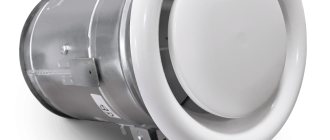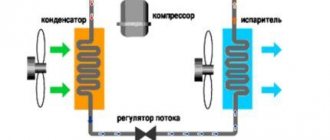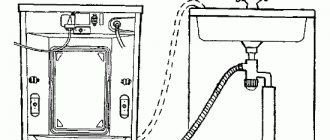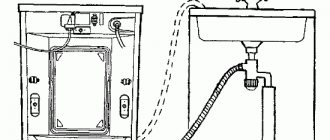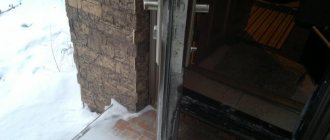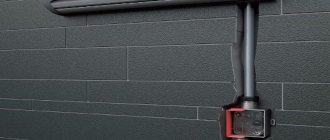We were wondering how to drain condensate from the air conditioner into the sewer correctly! Let's consider: drainage, check valve and drainage options. About everything in order in this article.
Air conditioning is becoming one of the mandatory elements not only in office or public buildings, but also in apartments or private houses. The operation of this device allows you to normalize the temperature in the room and provide a comfortable microclimate. A specific feature of using the device is the appearance of a significant amount of moisture, which must be removed somehow. The most successful option is to drain condensate from the air conditioner into the sewer. This method requires the creation of a water drainage system that operates according to certain rules.
Purpose of the device
Running a drainage hose outside through a hole in the wall is the easiest way to remove condensation. A flexible tube 80 cm long serves to drain the resulting moisture. A simple and affordable option has its drawbacks: it is prohibited by SNiP, drops fall on passers-by, and in winter the drainage pipe freezes. In a private house, erosion of the blind area is added. The optimal solution is to connect the air conditioner to the sewer. An indispensable condition for proper installation is the installation of a siphon with an odor-locking device. It allows liquid to pass in one direction and prevents not only odor but also dangerous gases from entering the room.
Drain circuit maintenance
After installing the condensate drainage system, it is necessary to take care of its functional condition. There are many malfunctions that arise during operation and require immediate attention.
Problem. Most often, the hole through which moisture is discharged into the drainage tube becomes clogged. The reason is dust and dirt accumulating in the hole. Debris settles and clogs the tube. The bath fills with liquid and it begins to flow along the walls onto the floor.
Solution. To avoid unpleasant consequences, you should regularly clean and rinse the tube. For washing, detergents that contain chlorine are suitable, since it copes with the task as effectively as possible.
Problem. If the pressure regulator malfunctions, ice build-up may appear on the evaporator. The reason for this is a decrease in the temperature outside, and as a result, the temperature of freon.
Solution. To prevent malfunctions, you should regularly perform technical inspections of the condensate drainage routes from the split system.
Problem. If the air conditioner is turned on for heating in winter, the moisture removal tube will quickly freeze, which will cause a breakdown.
Solution. When the temperature outside is below freezing, the split system should be turned off. You can buy a low-temperature kit designed to heat the compressor and drain tube. In this case, the air conditioner will be able to operate even at a temperature of -25 degrees.
Problem. Excess or lack of refrigerant can cause icing of the tubes and evaporator. The ice will melt and drip onto the floor.
Solution. Remember to monitor the refrigerant level. Contact the service center for refueling in a timely manner.
Problem. If the pump breaks down, the drainage system fails.
Solution. It is better to purchase equipment from official suppliers and install it responsibly.
Problem. An incorrect angle of inclination of the drainage tube will cause water stagnation. In the future it will drip onto the floor.
Solution. Follow the recommendations for creating a slope at the installation stage.
Siphon operating principle
A conventional siphon with a water seal has a U-shape. Water remains in the elbow connecting the inlet and outlet pipes, which acts as a barrier to the release of sewer odors. When using plumbing fixtures, the water in the water seal changes frequently, and the level does not have time to decrease. In the case of an air conditioner, the supply of moisture is uneven; if the equipment is not working, the condensation does not drain. The water seal dries out, and in the absence of a water barrier, gases penetrate into the room.
A non-return valve for draining the air conditioner helps prevent an unpleasant situation. The device blocks air and sewer drains, and allows condensate to pass through unhindered. An ABS ball or spring membrane is used as a locking mechanism.
When the unit is filled with water, the float rises, opening the exit to the sewer. After the liquid leaves, it lowers under its own weight, blocking the hole.
Conclusions and useful video on the topic
The following video will introduce you to the features of the system for draining condensed water during operation of the air conditioner:
When installing climate control equipment, it is necessary to take into account the features of the air conditioner drainage system. If the split system pipes were laid correctly and a water seal was installed, the operation of the unit will not cause inconvenience to anyone. It is better to decide where to dispose of condensate at the stage of designing the route and locating the blocks.
Would you like to talk about your own experience in organizing drainage for climate control equipment? Do you have information about an interesting and practical solution to a problem? Please leave comments in the block form below, ask questions, share your impressions and photos on the topic of the article.
Types of siphons
Devices are classified according to two criteria: design and method of removing moisture.
Arc-shaped model with water seal
The standard version is bulky in size. The height of the water seal should be between 140-320 mm. The pipes are made transparent for visual inspection. Outlet diameter 40 mm. To recharge the water seal, it is possible to connect a washing machine. The model is recommended for high pressure or vacuum in the drainage pipeline. Among the disadvantages of the unit: large size, favorable environment for the development of bacteria, the likelihood of drying out.
Design with water seal and odor-locking mechanism
Compact option, designed for hidden and open installation. The unit is equipped with a water seal and an odor-locking mechanism in the form of an ABS ball. When the water seal level drops, the shut-off valve closes the outlet pipe. The model is equipped with a cleaning chamber for collecting dirt. The entrance to the siphon is vertical or horizontal, pipe DN32. Horizontal outlet DN40.
Concealed system
Siphon for hidden installation with vertical connection
The siphon assembly for draining the air conditioner into the sewer is hidden in a plastic box. The unit body is installed in the wall. Placement type: vertical, water seal height 50 mm. Case size 100x100x60 mm. Two tubes are connected to the box - an inlet pipe and an outlet into the sewer. It is possible to connect drainage hoses of three diameters: 20, 26, 32 mm. Inside the case there is a transparent cassette with a water seal and an odor-locking device. The valve opens when condensate passes through and closes when the water leaves. The cassette is replaceable; you can remove it yourself and clean it of dirt.
The set includes a construction plug and a decorative cover with spring clips. When choosing the installation location, the requirement is taken into account - the minimum distance between the outlet pipe of the split system and the siphon is 2 m. To service the unit, it is enough to remove the decorative cover.
Dry aggregate
Using a water seal is a simple and cheap solution to the problem of sealing off unpleasant sewer odors. Without regular renewal of the water barrier, its benefits disappear.
A dry water seal for an air conditioner is a design with a membrane, a pendulum valve or a tube that performs the function of a check valve.
The most common option is an elastic tube with molecular memory. In its normal state, it is closed and blocks sewer gases. As water passes through, the tube opens and then returns to its original shape. Advantages of dry shutter:
- compact size;
- thanks to the smooth surface of the membrane or tube, the device does not become clogged;
- serves as a reliable barrier to the spread of odor from the sewer;
- does not freeze in winter;
- the absence of elbows ensures high throughput;
- Vertical and horizontal installation is acceptable.
A dry siphon is used not only for draining air conditioners; it is installed under bathtubs and sinks in the country.
The second classification point is the method of condensate release:
- vertical release;
- horizontal release;
- combined option.
Causes of condensation and ways of discharge
Warm air from the room enters the refrigeration radiator of the heat exchanger. There, as it cools, it “gives up” all the moisture contained in it. The principle of condensation can be demonstrated with a simple example. If you take any item out of the refrigerator, it will immediately become covered with droplets of water. This is condensation.
The amount of condensation depends on humidity. The more humid the air, the more condensation will be produced. Please note that bacteria multiply much faster in dry air, which can cause respiratory illness. When the air conditioner is running, you should ventilate the room more often.
The box-shaped structure with a ball locking device can be installed in both hidden and open ways. Equipped with a replaceable cassette for replacing a dirty one. When the siphon is open, it is convenient to observe the condition of the mechanism through the plastic transparent case
Why do you need condensate drainage from an air conditioner:
- Since condensate is predominantly water, and an air conditioner is a complex electromechanical device, their proximity can lead to a short circuit situation and premature breakdown of equipment.
- In just one day, one air conditioner can produce 20 liters of condensed liquid. And a whole ton can easily be collected from the office center. This is a serious risk of basement flooding.
- In stagnant water, mold, bacteria and other pathogens quickly develop.
The arguments provided are quite enough to understand how important it is to properly organize the drainage system to drain water from the air conditioner.
How to choose a siphon for draining condensate from an air conditioner
Siphons installed to drain condensate differ in size and design. When choosing a model, several criteria are taken into account:
- Diameter of the outlet pipe for condensate removal. The size of the drainage hose must match the inlet of the siphon.
- The free space for mounting the device is assessed. The dimensions of the model may not fit in the allocated area.
- For built-in siphons, the depth of the mounting niche in which the unit is installed is estimated.
- The throughput of the unit must correspond to the amount of condensate. The device specifications contain the necessary information. A siphon with low capacity is not suitable for air conditioners with a large volume of condensate.
- Rubber seals at the inlet and outlet of the unit ensure a tight connection. When placing the siphon under the sun's rays, ultraviolet radiation will quickly render them unusable. In such a situation, hidden installation is necessary.
Why do you need to clean your air conditioner, and what happens if you don’t?
In any room - even if it is cleaned daily and wet cleaning is done - there is always dust. The air conditioner doesn't take air from the street - it takes it from the room, runs it through itself, and puts it back out. That is, dusty air passes through it. Dust from it settles inside the case.
In addition to dust, the air conditioner can be contaminated by:
- fat deposits from cooking (if the appliance is in the kitchen or in the living room, which is combined with the kitchen);
- insects;
- animal fur.
If cleaning is not performed, the following consequences are possible:
- A dusty smell appears, which neither wet cleaning nor frequent ventilation will eliminate.
- Increases operating power and energy consumption.
- There may be harmful bacteria and microorganisms in the room. Even if you do wet cleaning, they can linger inside the air conditioner, and then get out of it again into the room, which is why it will not be possible to completely remove them. Thus, mold spores, dust mites, and legionella (the bacterium that causes legionellosis, a lung disease) can always “live” in the room.
- The heat exchanger and the freon inside it will overheat, which will increase the load on the compressor. As a result, the equipment will wear out faster, requiring repairs or even purchasing a new split system.
- Condensation (water) will drip from the indoor unit.
First of all, the indoor unit needs to be cleaned, since a large amount of dust accumulates in it. You can remove dust deposits from it yourself - since it is located in the apartment and is relatively easy to disassemble.
Periodically (ideally, once a year) it is worth cleaning the outdoor unit. It can become contaminated with dust, dirt deposited from car exhausts and industrial emissions, poplar fluff, leaves, and small branches. Sometimes some small objects may fall into it, fallen (or thrown out) by neighbors above.
Only owners of private houses, or if you live on the 1st floor, can clean the external unit yourself. In other cases, this becomes a difficult task, for which you will have to call in specialists.
How do you know when cleaning is needed?
It’s definitely time to clean your air conditioner if you notice the following “symptoms”:
- An unpleasant smell of dust that can be felt when the air conditioner is running, even after wet cleaning the room. It is best heard when the air conditioner is operating for heating. This is the most obvious sign that the filter is clogged.
- Power drops. For example: if last summer, at a street temperature of +30º, the air conditioner easily maintained the room temperature at +22º, turning on 2-3 times an hour, and this summer, in the same heat, it works continuously, or turns on more often.
- Electricity consumption has increased. This can only be noticed if you have a separate meter on the air conditioner outlet, and if you remember how much electricity the device consumed before under the same conditions.
- The noise during operation has increased. Due to dust, the fan is forced to operate at increased power.
- A “new” noise appeared during operation (hum, crackling, gurgling, squelching, or the equipment simply began to work louder). The noise may not be caused by contamination, but it is advisable to carry out an inspection.
- Water is dripping from the indoor unit. Most likely the problem is a clogged drainage system. During normal operation: the condensate that appears on the heat exchanger of the evaporation unit flows into a special tray and is discharged through a tube out of the room. If the tube becomes clogged, water overflows from the pan. In more expensive and newer models, a special pump is used to remove condensate. If it fails, the tray will also overflow.
How often should you clean, and when is the best time to do it?
There is no strict frequency - it depends on the following factors:
- how dusty it is in the room, and how often wet cleaning is done there;
- How long does the air conditioner last?
As for the indoor unit: it is recommended to clean the mesh filter once every 1-2 months if you use the air conditioner daily. Other elements - it is advisable to clean them (or at least inspect them if you do not use the air conditioner often) at least 1-2 times a year.
Difference between dirty and clean filter
Most often, cleaning is needed if your home is:
- next to the highway;
- in an industrial zone;
- next to poplars, and your windows are close to the crown;
- in an area where other buildings are being built.
It is best to carry out maintenance in the off-season - autumn or spring. If you use the air conditioner only for heating, you can clean it in the fall, after use. If the device is used in winter for heating, then it can be cleaned when it gets dirty.
Installation of drainage system
A flexible hose is laid from the drainage hole of the indoor unit of the air conditioner. To place it, a groove is punched into the wall.
The line should not make sharp turns; they prevent the uniform flow of liquid. Let's assume an angle of 45°.
To ensure the removal of condensate by gravity, the hoses are laid with a slope of 1-2 cm per 1 m of length. Sagging hoses are not allowed.
Before entering the sewer pipe, a siphon with a water seal is installed to cut off unpleasant odors. Installation is carried out using crimp nuts. The direction of flow is marked on the body of the unit. The arrow helps identify the inlet and outlet. The connection to the sewer network is made with a flow break. After installation, the system is tested.
Flaring of copper tubes
We move on to the stage of preparing the tubes.
Mistake No. 5 You can cut them only with a special pipe cutter, no hacksaws or grinders!
When making a cut, it is necessary to hold the end of the copper pipe strictly downward in order to prevent any chips from getting inside.
The ends are processed with a rimmer.
https://youtube.com/watch?v=lW7wjQICPOM%3F
Error No. 6 Flaring is done with a special tool with an eccentric. Don't forget to put the connecting nut on the tube before this step!
The width of the flare should be such that the connection eventually fits freely and unhindered into the nut.
The height of installation of the tube in the rolling clamp is strictly regulated.
The simplest and most proven old-fashioned way to determine the quality of rolling, at least at the initial stage, is to see your reflection in the “skirt”.
Flaring of the pipes of the outdoor unit will have to be done outdoors on weight. Otherwise, the line simply will not fit through the hole.
Error No. 7 Please note - if the installation does not take place on a hot, warm day, then when bringing copper pipes home from the street, close their ends and be sure to wait time for the copper to reach room temperature. If you bring them in cold and open, then due to the dew point effect, condensation will form inside the tube, which, on a poorly evacuated air conditioner, can lead to dire consequences
If you bring them in cold and open, then due to the dew point effect, condensation will form inside the tube, which, on a poorly evacuated air conditioner, can lead to dire consequences.
Main manufacturers
Hutterer & Lechner
The leader in the production of siphons for air conditioning systems is the Austrian company Hutterer & Lechner (HL). The products are distinguished by high quality and simplicity of design. The technology of equipping the units with a water seal and a locking ball valve prevents the appearance of unpleasant odors. The company offers siphons of various models:
- HL 136.2 - siphon with water seal;
- HL 138 - built-in system;
- HL 136 N is a unit with a water seal and a ball odor locking device.
Vecamo
The Italian company Vecamo offers a siphon for air conditioning, which is mounted on the wall, providing free access to the inlets and outlets. The kit includes connectors designed for drainage hoses of various diameters. The transparent plastic case allows you to monitor the condition of the internal part.
McAlpine
The self-closing drain valve or dry siphon of the MacValve series from McAlpine is produced in two installation sizes: 32 and 40 mm. The compact plastic case contains a polymer tube that functions as an odor-blocking device. Vertical installation is recommended, but horizontal installation is acceptable. In the first case, the throughput is 1.58-275 l/s, in the second it is lower - 0.7-1.7 l/s.
The design of siphons with a check valve for draining condensate into the sewer system was thought out by professionals. It is not possible to make such a device yourself. The only available option is a simple design with an elbow and a water barrier that can dry out at any time.
Health Impact Assessment
The danger of condensation lies not only in the possible flooding or breakdown of the air conditioner itself. The main threat is harm to health. There are several factors that contribute to the comfortable growth of bacteria: heat, dirt and water. What are not ideal conditions for the development of various diseases?
Black mold fungi can cause many serious diseases, including cancer. Bacteria often cause pneumonia. The mortality rate from Legionnaire's disease is very high.
If the drain hose is clogged, disconnect it and blow it out. If the system was installed correctly, without kinks, accumulated dirt should fly out from the opposite end
A disgusting smell is the least of all evils. The appearance of an unpleasant aroma clearly signals to the owner of the climate system that a major drainage cleaning is required.
Peculiarities
A dry siphon is nothing more than a pipe (and it can be vertical or horizontal). The siphon body can be made of plastic or polypropylene. At both ends of the tube there are special threaded shanks for fastening: one of them is attached to a household appliance, and the other goes into the sewer system.
The inside of the siphon contains a special device with a shutter that works like a valve. It is thanks to this design that the smell from the sewer does not pass into the room, since it blocks the cross-section of the siphon pipe.
This characteristic of a dry siphon is especially important in case of blockages and contamination (especially for those consumers who live on the first floors of apartment buildings): in the event of a breakdown of plumbing equipment, contaminated and unpleasant-smelling liquid will not flow into the room.
In addition to all of the above, several more features of the dry siphon should be noted, which are highlighted by regular users of this plumbing design.
- A dry siphon is a durable and reliable device. Its operation proceeds without complications; regular checks, cleaning or maintenance are not required. In addition, it retains its functionality for quite a long period.
- For proper and high-quality operation, almost all subtypes of siphons require the presence of water. Dry type construction is an exception to this rule.
- The device can be installed even in rooms that are not heated during the cold season.
- The material from which the dry siphon is made has anti-corrosion properties.
- The device is manufactured in accordance with the requirements of Russian standards, it has all the necessary licenses and certificates of conformity.
- Installing this design is a fairly simple process, so even a beginner can do it.
- Due to its compactness, as well as the possibility of both horizontal and vertical installation, the siphon can be installed even in complex plumbing systems in a small space.
- The internal design of the device prevents the constant accumulation and stagnation of water inside the pipe, and therefore is able to protect residents not only from unpleasant odors, but also from the appearance and proliferation of harmful bacteria and microbes.
Purpose
A siphon for a split system is a special device that connects the condensate outlet pipe to the sewer system. The main purpose of the device is to remove moisture from the air conditioner into drain lines and protect the premises from the unpleasant smell of sewage. Moreover, the use of a siphon provides aesthetics to the exterior of buildings by preventing water from flowing onto walls and sidewalks. At the same time, along with the aesthetic component, there is also a practical one.
Thus, water dripping from the outlet pipe forms puddles and excessively moistens the blind areas of houses. This, in turn, negatively affects the foundation and eventually leads to its destruction. In winter, air conditioners that are not equipped with a siphon run the risk of failure due to freezing of condensate inside the drain tube.
Purpose of the product
The operating principle of the air conditioning device is based on absorbing water from the air, which is why condensation occurs. Moisture remains on the cold plates of the heat exchanger, which is then collected in a special container - a drainage pipe. Therefore, it is believed that if water drains from the air conditioner (external tank), then this is its normal operating condition.
The constant dripping of water from the external drain pipe of the air conditioner does not bother many of its owners at all - it’s not dripping in the apartment. However, this situation can have many negative consequences:
- Constant dripping of water, especially when installing an air conditioner in a private house, can harm not only the blind area, but also the foundation of the building.
- When installing an air conditioner in an apartment building, dripping water can cause problems for the residents of the lower floors. Hardly anyone will be happy to listen to the constant knocking of drops on a window sill, balcony, or the wetness of the external wall of the apartment.
- The very sight of an air conditioning device with water dripping from it is not particularly pleasing to the eye.
- There are problems with using an air conditioning device in winter, since the liquid in the drain pipe may freeze and, as a result, break down the air conditioner itself.
In addition, the European Union has already completely banned the installation of air conditioners that allow condensation to enter the external environment. Domestic legislators may soon become concerned with this issue.
Review of popular models
Hepvo CV1WH
(Cost: about 1000 rubles). Siphon with a dry water seal (polymer membrane with molecular memory) with a check valve function. Inlet Diameter: 1/2¨ Outlet Diameter: 40mm
McAlpine MRNRV40
(Cost: about 1200 rubles). Siphon with dry water seal (silicone membrane with molecular memory) with check valve function. Inlet Diameter: 1/2¨ Outlet Diameter: 40mm
Hutterer & Lechner HL136.3
(Cost: about 3000 rubles). Siphon with mechanical locking device, with horizontal outlet and dirt collector. Threaded connection diameter: 5/4¨ Outlet diameter: 40mm
Self-production
In stores, siphons for drainage from an air conditioner cost from one and a half to two thousand rubles, and many users are thinking about making such a device themselves. Opinions on this matter are contradictory: some say unequivocally that it cannot be done - just buy it cheaper. But there is also the opposite opinion.
There are two options for homemade water seals:
Option No. 1. Without using special tools at home, you can bend a U-shaped pipe. Connect one end of it to the air conditioner, and insert the other into the sewer pipe. Such a device will pay off only when the split system is constantly in operation. But if the air conditioner is idle for a long time, the liquid will evaporate from the elbow of the device, and foul odors from the sewer pipe will fill the room.
Option No. 2. This method of making a dry water seal for wall or ceiling placement of an air conditioner. What is its essence? For such a homemade device, you will need a compensator (an ordinary plastic pipe with a narrower diameter of about 60 mm). A double-sided rubber cuff (from a washing machine) with a trimmed collar is inserted inside it.
A tennis ball is placed on top of the cuff hole. The lower part of the pipe is inserted into the sewer pipe, and a hose is inserted into the upper hole to drain condensate from the air conditioner. The principle of operation of such a dry water seal is as follows.
During operation of the split system, moisture is released from the heat exchanger, capillary tubes, radiator and other elements. Gradually, through the drip funnel of the outlet from the air conditioner drain, it flows down the outlet hose into the exposed compensator. The ball rises under the pressure of drainage fluid from the air conditioner, freeing it to drain into the sewer line. After the pressure from the condensate decreases, the ball moves into place under its own weight and tightly closes the hole.
You can watch the video for more information about making a dry water seal yourself:
